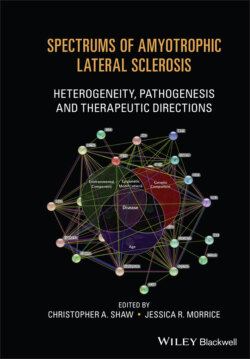Читать книгу Spectrums of Amyotrophic Lateral Sclerosis - Группа авторов - Страница 20
GENETIC MODELS TO STUDY ALS In Vivo Models
ОглавлениеALS is currently untreatable. Riluzole and edaravone, the two drugs approved by the US Food and Drug Administration (FDA), increase survival by a few months, blocking excessive glutamatergic neurotransmission and preventing oxidative stress damage, respectively, but they are not able to halt or cure the disease [80]. Genetic models represent a very useful tool to identify the concrete target of new drugs. Of course, no model can fully reproduce the human condition, especially its clinical heterogeneity, but a combination of in vitro and in vivo models can help to investigate the mechanisms underlying the disease and explore epistatic interactions. Since the first genetic discoveries, molecular biology techniques have made it possible to insert gene mutations and express mutant proteins in a number of animal models (see details in Chapter 8). Small animals such as Drosophila melanogaster and Danio rerio (zebrafish), have been widely used due to the simplicity and rapidity of manipulations, especially for drug screening. The zebrafish has many advantages in this sense, mostly because it is a vertebrate and has high genetic homology with humans. The zebrafish can be used at the embryonic stage, taking advantage of egg transparency and its rapid development, which can be followed in real time; and also at the adult stage, using transgenic lines. Motor phenotypes can be easily detected and analyzed, and in vivo imaging can be promptly performed. Genetic interactions can be tested as well as mechanisms of action of pathogenesis. High‐throughput drug screening can be done to test libraries containing thousands of chemical compounds at the same time. Since the zebrafish is not a mammal and does not have UMNs (the corticospinal and rubrospinal tracts are absent), it can be considered a very useful tool to study cellular dynamics in vivo and may be used prior to other models, such as rodents [81, 82].
A wide range of murine models has been created [83] but the most commonly used remains the first one developed: a transgenic strain carrying the SOD1G93A pathogenic variant [84]. This model has been used to test most drugs in preclinical phases. It should be noted that these treatments are administrated at the pre‐symptomatic stage, whereas ALS patients are treated after a disease onset that seems to be preceded by a long pre‐symptomatic period. To better investigate the pre‐symptomatic stage, a SOD1 pig model has recently been obtained [85]. Since pigs have a long lifespan, transgenic pigs, stably expressing the human pathological allele SOD1G93A, have a pre‐symptomatic phase of about 27 months. After this period, gait abnormality and concomitant dysphagia appear and progress rapidly with severe respiratory impairment. SOD1 animal models have been used in preclinical investigations of almost all drugs used in clinical trials. However, the principal limit of this model is that TDP‐43 pathology, which is present in about 97% of all ALS subtypes, is not detected in SOD1 mutated patients, suggesting different disease mechanisms. In addition, preclinical studies performed in mice have failed to be transferred to humans [86].
Considerable efforts have been undertaken to study the biological role of C9orf72, because its pathogenic expansion is the most frequent cause of ALS and FTD in populations of European descent. Drosophila, zebrafish, and rodents have been used to test various hypotheses of the C9orf72 mechanism, including loss of function, leading to haploinsufficiency of the gene, and gain of function, with the accumulation of RNA foci and dipeptide repeats (DPR) resulting from non‐conventional repeat translation. TDP‐43 inclusions are detectable in mice expressing the C9orf72 expanded allele, suggesting that TDP‐43 is downstream of C9orf72. Knockout mice show an inflammatory phenotype, thus implicating C9orf72 in immune regulation and the autophagic pathway [87]. Mice expressing the repeat expansion present with RNA foci and DPR, but they do not have a behavioral phenotype, suggesting that the gain of function is not sufficient to cause the disease [88, 89]. A combination of different mechanisms is probably required for disease development [90].
Different animal models, reproducing mutations in different genes, are needed to investigate ALS in its complexity along with the clinical overlap with other diseases of the spectrum. For example, a transgenic mouse has recently been described, carrying the MATR3S85C variant. This model shows myopathic histological changes: TDP‐43 aggregates in muscles, and respiratory problems occur due to myopathic changes in diaphragm muscles. Interestingly, the observed myotoxicity recapitulates the clinicopathological features of distal myopathy and ALS [91]. Also, a TBK1 mouse, recently developed, reproduces the main symptoms of ALS/FTD. Mice carrying the conditional neuronal deletion of TBK1 show memory deficits and reduced locomotor activity. Interestingly, TBK1 overexpression extended the lifespan of symptomatic mice not only for TBK1 knockout strains but also for SOD1G93A mice, thus suggesting that TBK1 and SOD1 are probably part of the same pathway and can be targeted by the same drugs [92].
By comparing phenotypes across ALS models carrying mutations in different genes, it is possible to study the disease as broadly as possible.
